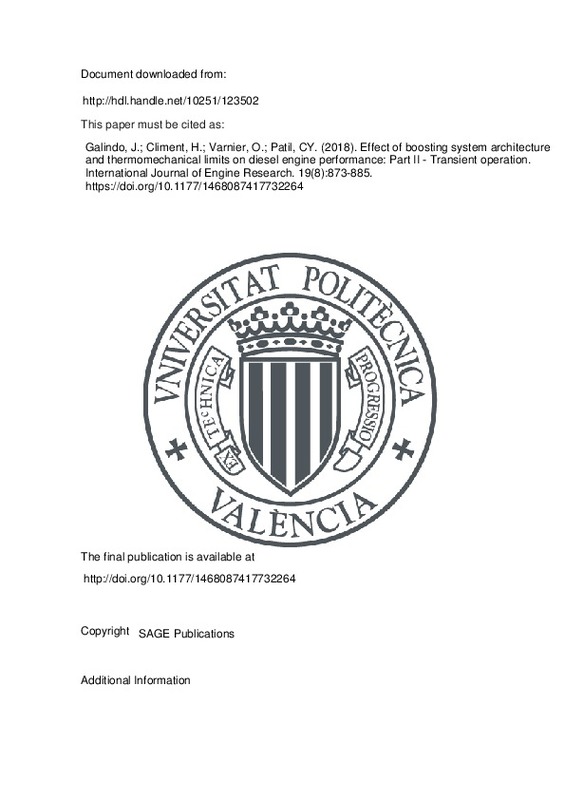JavaScript is disabled for your browser. Some features of this site may not work without it.
Buscar en RiuNet
Listar
Mi cuenta
Estadísticas
Ayuda RiuNet
Admin. UPV
Effect of boosting system architecture and thermomechanical limits on diesel engine performance: Part II - Transient operation
Mostrar el registro sencillo del ítem
Ficheros en el ítem
| dc.contributor.author | Galindo, José
|
es_ES |
| dc.contributor.author | Climent, H.
|
es_ES |
| dc.contributor.author | Varnier, O.
|
es_ES |
| dc.contributor.author | Patil, Chaitanya Yashvant
|
es_ES |
| dc.date.accessioned | 2019-07-11T20:01:47Z | |
| dc.date.available | 2019-07-11T20:01:47Z | |
| dc.date.issued | 2018 | es_ES |
| dc.identifier.issn | 1468-0874 | es_ES |
| dc.identifier.uri | http://hdl.handle.net/10251/123502 | |
| dc.description.abstract | [EN] Nowadays, internal combustion engine developments are focused on efficiency optimization and emission reduction. Increasing focus on world harmonized ways to determine the performance and emissions on Worldwide harmonized Light vehicles Test Procedure cycles, it is essential to optimize the engines for transient operations. To achieve these objectives, the downsized or downspeeded engines are required, which can reduce fuel consumption and pollutant emissions. However, these technologies ask for efficient charging systems. This article consists of the study of different boosting architectures (single stage and two stage) with a combination of different charging systems like superchargers and e-boosters. A parametric study has been carried out with a zero-dimensional engine model to analyze and compare different architectures on the different engine displacements. The impact of thermomechanical limits, turbo sizes and other engine development option characterizations is proposed to improve fuel consumption, maximum power and performance of the downsized/downspeeded diesel engines during the transient operations. | es_ES |
| dc.language | Inglés | es_ES |
| dc.publisher | SAGE Publications | es_ES |
| dc.relation.ispartof | International Journal of Engine Research | es_ES |
| dc.rights | Reserva de todos los derechos | es_ES |
| dc.subject | Transient operations | es_ES |
| dc.subject | Charging system | es_ES |
| dc.subject | Zero-dimensional modeling | es_ES |
| dc.subject | Thermomechanical limits | es_ES |
| dc.subject | Diesel engines | es_ES |
| dc.subject.classification | MAQUINAS Y MOTORES TERMICOS | es_ES |
| dc.title | Effect of boosting system architecture and thermomechanical limits on diesel engine performance: Part II - Transient operation | es_ES |
| dc.type | Artículo | es_ES |
| dc.identifier.doi | 10.1177/1468087417732264 | es_ES |
| dc.rights.accessRights | Abierto | es_ES |
| dc.contributor.affiliation | Universitat Politècnica de València. Departamento de Máquinas y Motores Térmicos - Departament de Màquines i Motors Tèrmics | es_ES |
| dc.description.bibliographicCitation | Galindo, J.; Climent, H.; Varnier, O.; Patil, CY. (2018). Effect of boosting system architecture and thermomechanical limits on diesel engine performance: Part II - Transient operation. International Journal of Engine Research. 19(8):873-885. https://doi.org/10.1177/1468087417732264 | es_ES |
| dc.description.accrualMethod | S | es_ES |
| dc.relation.publisherversion | http://doi.org/10.1177/1468087417732264 | es_ES |
| dc.description.upvformatpinicio | 873 | es_ES |
| dc.description.upvformatpfin | 885 | es_ES |
| dc.type.version | info:eu-repo/semantics/publishedVersion | es_ES |
| dc.description.volume | 19 | es_ES |
| dc.description.issue | 8 | es_ES |
| dc.relation.pasarela | S\370415 | es_ES |







![[Cerrado]](/themes/UPV/images/candado.png)

